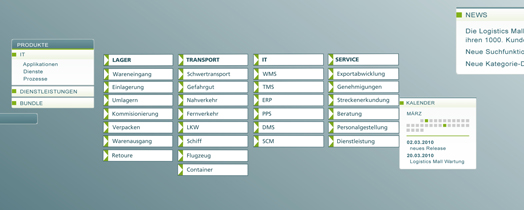Key Project 1 - Design Methodology for Logistics Services
In today’s market, a comprehensive range of logistics services consists of a complex entity of activities, IT services, and processes, which are often carried out by different companies. As a result, designing the logistics processes required for providing these types of services has become a complex task. The goal of the key project "Design Methodology for Logistics Services" is to help the participating companies with this design task by defining innovative logistics processes by combining logistics services and logistics IT services, making these new processes machine executable, and implementing them. To achieve these goals, the following were developed as part of the project:
- Procedure model and methodology for designing cloud-ready logistics processes,
- Fundamental application ontologies (reference) with defined semantically-described logistics business objects and IT services,
- Tool support for adapting the reference ontologies to individual needs,
- Cloud-based modelling tool for logistics processes that supports the procedure model (Logistics Process Designer).
Logistics activities and IT functions were combined into complex logistics processes based on one or more prioritized goals using the procedure model. Accordingly, the procedure model has to represent the definition of the strategic business goals and the operating goals derived from them. The important elements of the procedure model and the associated design methodology constitute the definition of (logistics) objects as well as the activities that are an integral component of the logistics services and logistics IT services. An application ontology is required for the formal semantic definition of the objects and activities of the logistics subareas.
In computer science, ontologies are used for knowledge representation. They contain concepts, also called classes, and the relations between these concepts. Instances of a concept represent the objects of an ontology. A logical language is used to define the rules (inference and integrity rules) for the components of ontologies. These rules translate the verifiability of the desired attributes of an ontology (for example, consistency). This is therefore a semantic technology that first describes the semantics of services and then serves to define the statistical aspects of an area of application.
The translation of a clearly semantic description of the relevant objects, services, and processes requires the agreement of rules between the users and the ontology as well as the use of logic. The semantics-oriented ontology is essential in helping to combine the logistics services and logistics IT services into complex logistics processes out of a building block.
Providing the user with a modelling tool in the cloud (Logistics Service Designer), which supports the design methodology of the procedure model to be developed, has many benefits including the following: The logistics company is able to design new logistics services and logistics IT services. The application ontology in the modelling tool results in the standardized use of business objects and activities. The ontology also includes mappings to IT services provided by different IT vendors to ensure the interoperability of the services in the context of the necessary IP support required for providing logistics services. The modelling tool, which is offered as a SaaS solution, is rapidly available, has no licencing fees, and requires no installation or maintenance work.
The combination of the logistics and IT services into complex logistics processes requires that the Logistics Mall platform has a suitable infrastructure and platform-bound modelling tools. These tools have to use the semantics-based ontology to identify the necessary services and place them in the right sequence. They also have to fulfil basic functions, such as the conditions for calling the individual services as well as defining dependencies and alternatives, and implement the structured repository of the orchestrated logistics processes on the Logistics Mall. The resulting requirements, such as transaction security or the dynamic coupling of IT services to runtime (orchestration of logistics processes), are met through the use of an orchestration engine. This engine has monitoring and control mechanisms that are able to instantiate and execute the individual processes whereby the predefined workflow for the planned business processes is adhered to and implemented.
 Fraunhofer-Institute for Material Flow and Logistics IML
Fraunhofer-Institute for Material Flow and Logistics IML